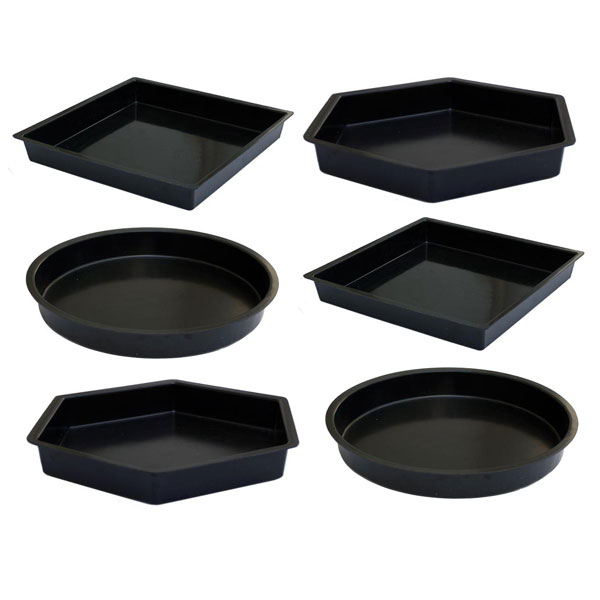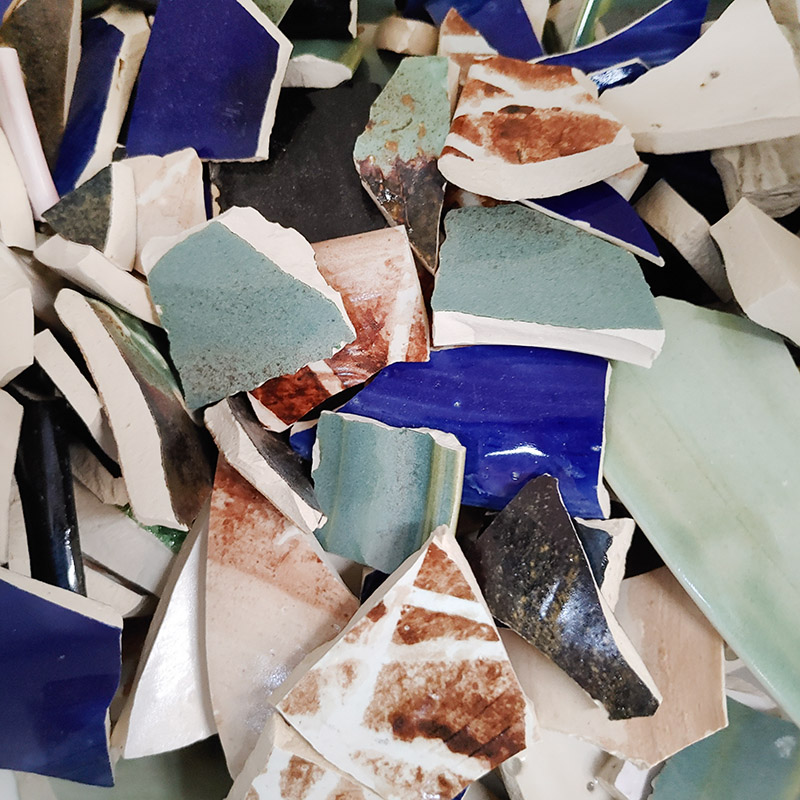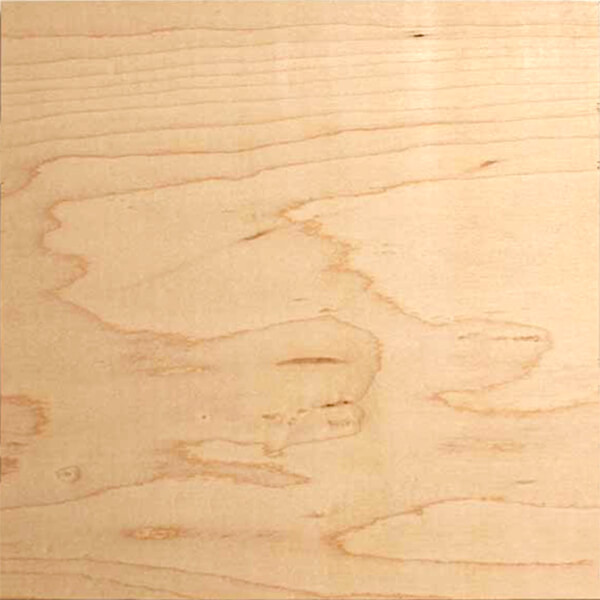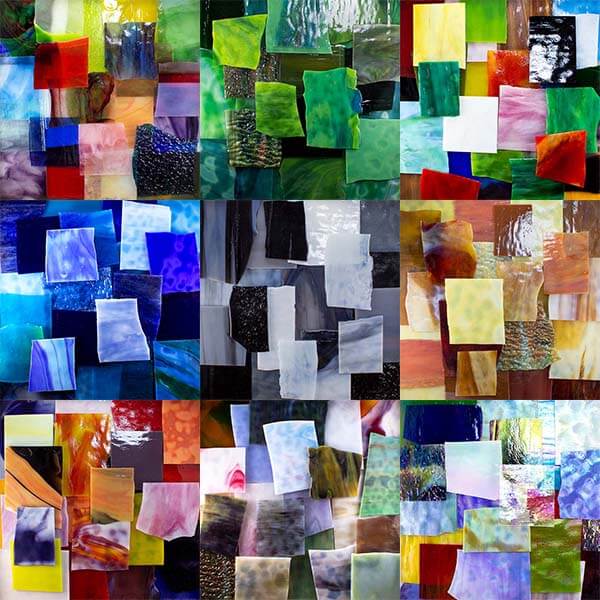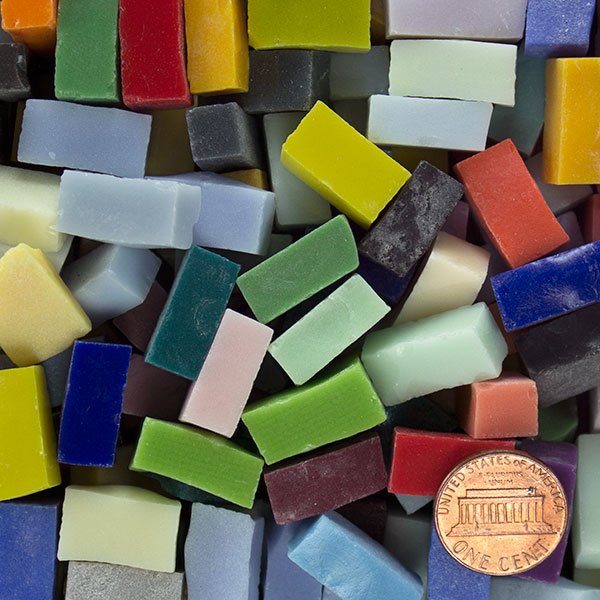
Smalti Assortment SM-MX00 1-POUND is a bulk assortment of our smalti. This mix contains all of the colors we carry, but there may be more of some colored tiles and fewer of others. We try to homogenize the blend, but getting an exactly even amount of each color would be exceedingly difficult.
Smalti is traditional hand-cut mosaic glass that has a different look and feel from molded tile. It is the glass to use for reproducing religious icons, antique mosaic art, or making modern interpretations of classical designs. This assortment is sold by the pound, which is 160+ pieces on average.
Mud Turtle Mosaic™ brand smalti is a next-generation smalti. It looks like ordinary smalti (non-molded hand-cut rectangles), but it can be cut more predictably and cleanly with less waste and fewer shards, which often an issue with smalti. Avoid having to discard a significant percentage of your expensive materials as cutting scrap. This brand cuts more efficiently because of how it is poured and cooled. With Mud Turtle Mosaic™ smalti, extra care is taken to ensure that the mixture is more homogeneous and that little or no cold seams are formed during the pouring of the molten material out on the slab. The result is that are fewer blobs and swirls and fault plains inside the glass. These artificial internal structures are what causes regular smalti to break in such odd ways and form such vicious finger-poking shards. With this brand, there are also fewer surface pits and crevices for grouts and mortars to contaminate.
Product Coverage
Traditionally mosaics made from smalti were not grouted. However, if your mosaic will be outdoors or in a wet location, then you need to leave a gap between the tiles so that if can be filled with grout to seal out moisture. Having a grout gap means that you will need about 10 to 15% less smalti than otherwise.
Piece Count
One sales unit (1 pound) USUALLY contains 160+ pieces, with 168 being the average for the material we sampled. However, the smalti is sold by weight, and if the factory cuts a batch with slightly larger pieces, then that batch will have fewer pieces per pound.
Compatibility
Smalti is hand cut when it is made at the factory, and so it had a different look and feel from regular molded glass mosaic tile that is pressed into a uniform shape. Smalti is also significantly thicker than most of the glass tile we sell. For these reasons, mosaics look best when they are made from one type material or the other but not both.
Cutting Smalti
Mud Turtle Mosaic™ Smalti cuts extremely well with the mosaic glass cutters that we sell.
Smalti Mosaic Glass
- Price for this assortment is per pound, which is USUALLY 160+ pieces.
- The factory could potentially cut the pieces slightly larger, which would reduce the piece count per pound.
- hand-cut non-molded rectangular pieces.
- variable dimensions: ~1/4 inch x ~5/8 inch x ~1/4 inch thick.
- coverage: about 2.5 to 3 pounds per square foot with coverage being affected by how the smalti is cut by the artist.
- Pigments: colorfast metal oxide.
- Solid color throughout.
- Opaque.
- Cut surface is glossy.
- Cuts relatively easily with mosaic glass cutters.
- Heat, frost and chemical resistant.
- Suitable for both commercial and residential installation, indoors and out.
Use in Mosaic Art
This smalti is probably the best you can find if you need to render small details in smalti because it can be cut smaller with less waste than other brands. It also has little or no surface pitting, so you can grout a mosaic made from this material without having specks of grout remaining all over the face of the mosaic in pits. The product is highly recommended.
How To Make Mosaic Art
For more advice on designing your mosaic project or mounting, cutting, and grouting tile, please see our page of Mosaic Frequently Asked Questions or our Mosaic Information Guide, which lists instructional pages described by topic. We also post new articles about making mosaics at our How to Mosaic Blog.
 Smalti Sample Board contains all the colors of Mud Turtle Mosaic™ brand smalti that we currently carry. The factory makes some intermediate tints in addition to the tints shown on the board, but we don’t carry those simply because they are hard to distinguish from the tints we already have. We carry all the factory’s hues. The rest of the information below describes the smalti:
Smalti is traditional hand-cut mosaic glass that has a different look and feel from molded tile. It is the glass to use for reproducing religious icons, antique mosaic art, or making modern interpretations of classical designs. It is sold by the 1/4 pound, which is 40+ pieces on average.
Mud Turtle Mosaic™ brand smalti is a next-generation smalti. It looks like ordinary smalti (non-molded hand-cut rectangles), but it can be cut more predictably and cleanly with less waste and fewer shards, which often an issue with smalti. Avoid having to discard a significant percentage of your expensive materials as cutting scrap. This brand cuts more efficiently because of how it is poured and cooled. With Mud Turtle Mosaic™ smalti, extra care is taken to ensure that the mixture is more homogeneous and that little or no cold seams are formed during the pouring of the molten material out on the slab. The result is that are fewer blobs and swirls and fault plains inside the glass. These artificial internal structures are what causes regular smalti to break in such odd ways and form such vicious finger-poking shards. With this brand, there are also fewer surface pits and crevices for grouts and mortars to contaminate.
Smalti Sample Board contains all the colors of Mud Turtle Mosaic™ brand smalti that we currently carry. The factory makes some intermediate tints in addition to the tints shown on the board, but we don’t carry those simply because they are hard to distinguish from the tints we already have. We carry all the factory’s hues. The rest of the information below describes the smalti:
Smalti is traditional hand-cut mosaic glass that has a different look and feel from molded tile. It is the glass to use for reproducing religious icons, antique mosaic art, or making modern interpretations of classical designs. It is sold by the 1/4 pound, which is 40+ pieces on average.
Mud Turtle Mosaic™ brand smalti is a next-generation smalti. It looks like ordinary smalti (non-molded hand-cut rectangles), but it can be cut more predictably and cleanly with less waste and fewer shards, which often an issue with smalti. Avoid having to discard a significant percentage of your expensive materials as cutting scrap. This brand cuts more efficiently because of how it is poured and cooled. With Mud Turtle Mosaic™ smalti, extra care is taken to ensure that the mixture is more homogeneous and that little or no cold seams are formed during the pouring of the molten material out on the slab. The result is that are fewer blobs and swirls and fault plains inside the glass. These artificial internal structures are what causes regular smalti to break in such odd ways and form such vicious finger-poking shards. With this brand, there are also fewer surface pits and crevices for grouts and mortars to contaminate.
